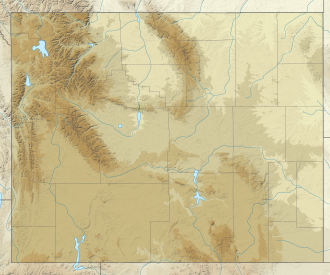| Guernsey State Park | |
|---|---|
 | |
| Location | Platte County, Wyoming, United States |
| Coordinates | 42°19′3″N104°49′11″W / 42.31750°N 104.81972°W [1] |
| Area | 8,631 acres (3,493 ha) [2] |
| Elevation | 4,423 ft (1,348 m) [1] |
| Established | 1934 |
| Administered by | Wyoming State Parks, Historic Sites & Trails |
| Designation | Wyoming state park |
| Website | Official website |
Lake Guernsey State Park | |
 Guernsey State Park Museum | |
| Area | 3,760 acres (original) 8,602 acres (increase) [3] |
| Built | 1934-39 |
| Architect | Roland Pray (original) S. R. Deboer; Richard G. Redell (expanded) |
| Architectural style | National Park Service Rustic, Bungalow/Craftsman |
| NRHP reference No. | 80004051 (original) 97001260 (increase) [3] |
| Significant dates | |
| Added to NRHP | August 26, 1980 (original) September 25, 1997 (increase) |
| Designated NHLD | September 25, 1997 [4] |
Guernsey State Park is a public recreation area surrounding the Guernsey Reservoir, an impoundment of the North Platte River, one mile northwest of the town of Guernsey in Platte County, Wyoming. The state park has campgrounds, boat ramps and hiking trails as well as exceptional examples of structures created by the Civilian Conservation Corps in the 1930s. [5] Facilities are managed for the Bureau of Reclamation by the Wyoming Division of State Parks and Historic Sites. [6]

